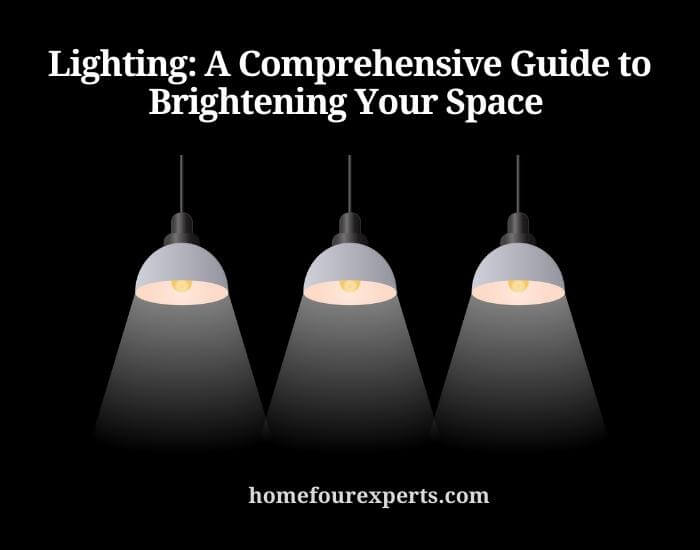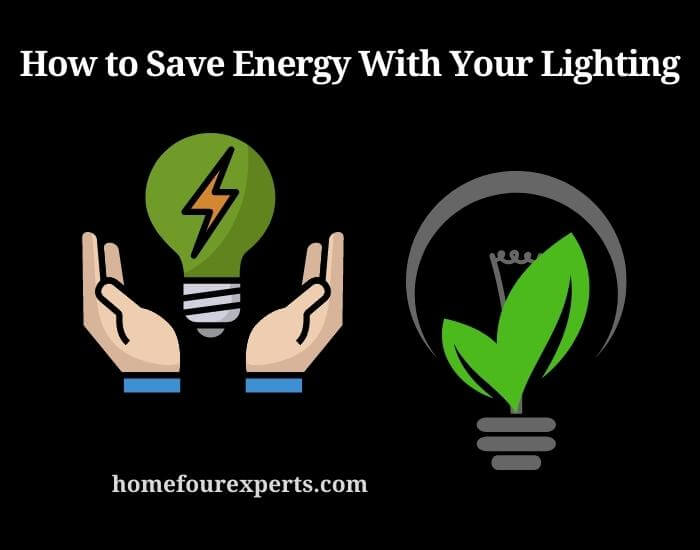Published on: February 22, 2023
Written by Eric Devin / Fact-checked by David Rowan
Lighting is a crucial aspect of any space that can completely transform its appearance and functionality. From creating a cozy ambiance in your bedroom to providing bright task lighting in your home office, the right lighting can make all the difference.

With so many lighting options available, it can be overwhelming to choose the right fixtures and bulbs for your space. In this comprehensive guide, we’ll take you through everything you need to know about lighting, including the different types of lighting fixtures, and light bulbs, and how to layer them to achieve the perfect lighting scheme for your space.
Whether you’re renovating your home or just looking to update your lighting, this guide will provide you with all the information you need to brighten up your space.
The Different Types of Lighting Fixtures
When it comes to lighting, there are several different types of fixtures to choose from, each with its own unique style and function. Here are some of the most common types of lighting fixtures you’ll come across:
Pendant Lights:
Pendant lights are a popular choice for kitchens and dining rooms, as they can provide focused lighting over a specific area. These fixtures hang from the ceiling and come in a variety of styles and sizes, from simple and modern to ornate and decorative.
Chandeliers:
Chandeliers are classic lighting fixtures that can add elegance and sophistication to any space. These fixtures typically feature multiple arms with light bulbs and are often adorned with crystals or other decorative elements.
Flush Mounts:
Flush mounts are a great option for rooms with low ceilings, as they sit close to the ceiling and take up minimal space. These fixtures come in a range of styles, from sleek and modern to more traditional designs.
Sconces:
Sconces are wall-mounted fixtures that can provide ambient or task lighting, depending on the style and placement. They are a great option for hallways, bedrooms, and bathrooms.
Table Lamps:
Table lamps are a versatile lighting option that can be used to add both task and ambient lighting to a room. They come in a range of styles and sizes, from small and minimalist to large and ornate.
Floor Lamps:
Floor lamps are another versatile option that can be used to provide ambient or task lighting. These lamps stand on the floor and can be moved around as needed, making them a great option for flexible lighting in a living room or home office.
The type of lighting fixture you choose will depend on your personal style, the function of the room, and the overall design of your space.
Understanding Light Bulbs
Understanding light bulbs is an important part of choosing the right lighting for your space. There are several types of light bulbs available, each with its own unique characteristics and uses. Here are the most common types of light bulbs:
| Incandescent Bulbs | Incandescent bulbs are traditional light bulbs that have been around for over a century. They produce a warm, yellow light and are available in a range of wattages. However, they are not very energy-efficient and have a shorter lifespan than other types of bulbs. |
| Halogen Bulbs | Halogen bulbs are similar to incandescent bulbs but are more energy-efficient and have a longer lifespan. They produce a bright, white light and are often used in task lighting fixtures. |
| Compact Fluorescent Bulbs (CFLs) | CFLs are a type of energy-efficient bulb that uses less energy than incandescent bulbs and last longer. They produce a cooler, bluer light and are available in a range of shapes and sizes. |
| Light Emitting Diodes (LEDs) | LEDs are the most energy-efficient type of bulb and have the longest lifespan. They produce a range of colors and are available in a range of shapes and sizes. LEDs are often used in modern lighting fixtures and can be dimmed for more flexible lighting. |
| Smart Bulbs | Smart bulbs are a relatively new type of bulb that can be controlled using a smartphone or voice assistant. They can be dimmed, change color, and can be programmed to turn on and off at specific times. |
How to determine the lighting needs of Your Space?
Determining the lighting needs of your space is an important step in creating a functional and comfortable environment. The function of the room should be the primary consideration when determining lighting needs. For example, a kitchen will require bright task lighting for food preparation, while a living room will require softer ambient lighting for relaxation.

The size of the room will also affect the lighting needs. A small room may only require one or two light sources, while a larger room may require multiple sources of light to ensure even illumination.
The height of the ceiling will also affect the type of lighting needed. A high ceiling may require pendant lighting or recessed lighting to provide adequate illumination, while a lower ceiling may be better suited to flush mount fixtures.
The amount of natural light entering the room should also be considered. Rooms with large windows or skylights may require less artificial lighting during the day, while rooms with limited natural light may require more artificial lighting.
The color scheme of the room should also be considered when choosing to light. Lighter colors will reflect more light and may require less artificial lighting, while darker colors may require more lighting to prevent the room from feeling too dim.
Personal preference should also be considered when choosing to light. Some people prefer bright, cool lighting while others prefer softer, warmer lighting.
It’s also important to consider energy efficiency when choosing to light, as energy-efficient bulbs and fixtures can help reduce your electricity bill and minimize your environmental impact.
How to Layer Lighting Fixtures for the Perfect Ambiance?
Layering lighting fixtures is a great way to create the perfect ambiance in your space. By using multiple light sources, you can create a variety of lighting levels to suit different activities and moods. Here are some tips for layering lighting fixtures:
- Start with Ambient Lighting: Ambient lighting provides overall illumination and should be the first layer of lighting to consider. This can be achieved through ceiling fixtures, chandeliers, or recessed lighting. Choose fixtures that provide even illumination throughout the room.
- Add Task Lighting: Task lighting provides focused illumination for specific activities, such as reading, cooking, or working. This can be achieved through table lamps, floor lamps, or under-cabinet lighting. Place these fixtures where they will provide the best illumination for the task at hand.
- Incorporate Accent Lighting: Accent lighting is used to highlight specific features in a room, such as artwork or architectural details. This can be achieved through wall sconces, track lighting, or picture lights. Choose fixtures that provide a soft glow to draw attention to the feature being highlighted.
- Use Dimmers: Dimmers allow you to adjust the level of illumination in a room, making it easy to create the perfect ambiance for any occasion. Install dimmers on all lighting fixtures for maximum flexibility.
- Consider Color Temperature: The color temperature of your light bulbs can also affect the ambiance of your space. Cooler temperatures (5000K-6000K) provide a bright, white light that is ideal for task lighting, while warmer temperatures (2700K-3000K) provide a softer, more relaxing light that is ideal for ambient and accent lighting.
Remember to consider the function of the room, the size of the space, and your personal style when choosing lighting fixtures and bulbs. With a little planning and creativity, you can create the perfect ambiance in any room of your home.
Lighting Tips for Specific Rooms
When it comes to lighting, different rooms have different needs. Here are some tips for selecting the right lighting for specific rooms in your home:
Kitchen:
The kitchen is a high-activity area that requires good task lighting. Install under-cabinet lighting to illuminate work surfaces and overhead lighting with a warm color temperature for overall illumination. Pendant lights over the kitchen island or dining table can add an extra layer of ambient lighting.
Living Room:
The living room is a space for relaxation and entertainment, so it should have a variety of lighting options to suit different moods. Use a combination of floor lamps, table lamps, and overhead lighting to create a warm and inviting atmosphere. Dimmers are a great addition to living rooms, as they allow you to adjust the lighting level to suit your needs.
Bathroom:
The bathroom requires a combination of task and ambient lighting. Vanity lighting should be placed at eye level to avoid shadows on the face. Overhead lighting can provide ambient lighting, while sconces on either side of the mirror can add an extra layer of task lighting.
Bedroom:
The bedroom is a space for relaxation, so the lighting should be warm and inviting. Use a combination of table lamps, floor lamps, and overhead lighting to create a cozy atmosphere. Dimmers can be especially useful in the bedroom, as they allow you to adjust the lighting level to suit your mood.
Home Office:
The home office requires good task lighting to reduce eye strain and improve productivity. Use a combination of overhead lighting and task lighting, such as a desk lamp, to provide adequate illumination. Choose bulbs with a cool color temperature for improved focus.
Don’t be afraid to mix and match different types of lighting fixtures to achieve the desired effect. With a little planning and creativity, you can create the perfect lighting scheme for your home.
How to Save Energy With Your Lighting?
Lighting can be a significant source of energy consumption in your home. Fortunately, there are several ways to save energy and reduce your electricity bill without sacrificing the quality of your lighting. Here are some tips for saving energy with your lighting:

- LED bulbs are more energy-efficient than traditional incandescent bulbs, and they last longer. They use up to 80% less energy and can save you money on your electricity bill.
- Dimmer switches allow you to adjust the lighting level to suit your needs, and they can help you save energy. By reducing the brightness of your lights, you can reduce the amount of energy you use.
- It may seem obvious, but turning off lights when you leave a room can save a significant amount of energy. Encourage your family members to get into the habit of turning off lights when they leave a room.
- Motion sensors can automatically turn lights on and off when you enter or leave a room. They can be especially useful in areas such as hallways and closets, where you may forget to turn off the lights.
- Take advantage of natural light whenever possible. Open curtains and blinds during the day to let in natural light, and turn off unnecessary artificial lights.
- Task lighting, such as a desk lamp or reading lamp, can provide focused lighting where you need it. By using task lighting instead of overhead lighting, you can save energy and reduce glare.
Not only will you save money, but you’ll also reduce your carbon footprint and help protect the environment.
Outdoor Lighting
Outdoor lighting is an essential aspect of any home’s exterior design. It not only provides safety and security but can also enhance the curb appeal of your property.
Before you start shopping for outdoor lighting fixtures, consider your lighting needs. Do you need lighting for safety and security, or do you want to create a welcoming ambiance for your outdoor space?
There are several types of outdoor lighting fixtures to choose from, including wall-mounted lights, post lights, and landscape lighting. Each type of fixture serves a different purpose, so choose the one that best meets your needs.
The style of your home should guide your choice of outdoor lighting fixtures. If you have a modern home, consider sleek, minimalist fixtures. If you have a traditional home, consider lantern-style fixtures.
Outdoor lighting should be installed strategically to maximize its effectiveness. For example, place lights near stairs and walkways to improve safety, and place lights near outdoor seating areas to create a welcoming ambiance.
Outdoor lighting fixtures can use a significant amount of energy, so choose energy-efficient bulbs to reduce your electricity bill. LED bulbs are a great choice for outdoor lighting because they are long-lasting and energy-efficient.
Outdoor lighting can be automated to turn on and off at specific times or in response to a motion. This not only adds convenience but also enhances security by making it look like someone is home.
You can choose and install outdoor lighting that enhances the beauty and safety of your home while reducing your energy consumption by doing the process.
Lighting Design Trends
Lighting design trends are constantly evolving, with new technologies and styles emerging every year. Here are some of the latest trends in lighting design:
- Industrial-style lighting: Industrial-style lighting fixtures, such as bare bulbs and exposed pipes, are becoming increasingly popular in residential and commercial spaces. These fixtures have a minimalist, utilitarian look that adds character to any space.
- Smart lighting: Smart lighting technology allows you to control your lights with your smartphone or voice assistant. You can set schedules, dim the lights, and change the color temperature with a few taps on your phone.
- LED filament bulbs: LED filament bulbs mimic the look of vintage incandescent bulbs but use far less energy. They have a warm, soft glow that creates a cozy ambiance in any space.
- Biophilic lighting: Biophilic lighting is designed to mimic natural light and bring the outdoors inside. This type of lighting uses color temperature and intensity to create a more natural, organic ambiance.
- Statement lighting: Statement lighting fixtures, such as oversized chandeliers and sculptural pendant lights, are becoming more popular in residential and commercial spaces. These fixtures add drama and style to any space and can serve as a focal point for the room.
- Minimalist lighting: Minimalist lighting fixtures have a sleek, modern look that complements contemporary interiors. These fixtures have clean lines and simple shapes, and they often incorporate LED technology.
Final Thoughts
Lighting plays a vital role in enhancing the ambiance, mood, and functionality of any space. By understanding the different types of lighting fixtures, light bulbs, and lighting design trends, you can make informed decisions about your lighting needs and create a space that is both functional and stylish.
Whether you’re looking to save energy, create a cozy ambiance, or make a statement with your lighting, there are plenty of options available to help you achieve your goals. So, start exploring the world of lighting today and see how you can transform your space with the power of light.
About This Writer

Hi, I am Eric Devin and I am a professional interior architect. Since childhood, I've always enjoyed DIY projects! And, I have loved to solve simple household problems using essential tools and equipment. I have also acquired a lot of information about basic household tools settings by working with contractors.